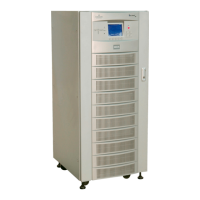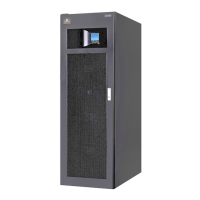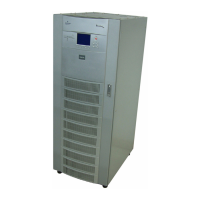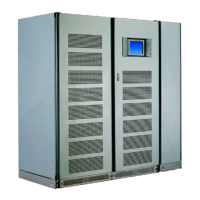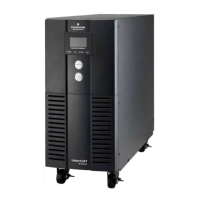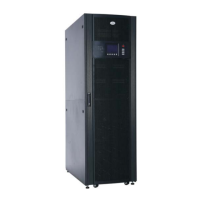UPS Electrical Installation
7
2.0 UPS ELECTRICAL INSTALLATION
This chapter provides guidelines for qualified installers who must have knowledge of local wiring
practices pertaining to the equipment to be installed.
2.1 External Protective Devices
For safety, it is necessary to install circuit breakers in the input AC supply and external battery
system. Given that every installation has its own characteristics, this section provides guidelines for
qualified installation personnel with knowledge of operating practices, regulatory standards and the
equipment to be installed.
External overcurrent protection must be provided. See Figures 51, 52 and 53 for overload capacity.
2.2 Power Cables
The UPS requires both power and control cabling. All control cables, whether shielded or not, should
be run separately from the power cables in metal conduits or metal ducts that are electrically bonded
to the metalwork of the cabinets to which they are connected.
The cable design must comply with the voltages and currents in Tables 12 through 15, follow local
wiring practices and take into consideration the environmental conditions (temperature and physical
support media), room temperature and conditions of installation of the cable and system’s overload
capacity (see 5.0 - Specifications).
When sizing battery cables, a maximum volt drop of 2VDC is permissible at the current ratings given
in Table 15.
The following are guidelines only and are superseded by local regulations and codes of practice where
applicable:
• Take special care when determining the size of the neutral cable (grounded conductor), because
current circulating on the neutral cable may be greater than nominal current in the case of non-
linear loads. Refer to the values in Table 11.
• The grounding conductor should be sized according to the fault rating, cable lengths, type of pro-
tection, etc. The grounding cable connecting the UPS to the main ground system must follow the
most direct route possible.
• Consideration should be given to the use of paralleled smaller cables for heavy currents, as this
can ease installation considerably.
• AC and DC cables must be run in conduits according to local codes, national codes and standard
best practices. This will prevent creation of excess EMI fields.
WARNING
Risk of electrical shock. Can cause injury or death.
The UPS contains high DC as well as AC voltages. Check for voltage with both AC and DC
voltmeters before working within the UPS.
Only properly trained and qualified personnel wearing appropriate safety headgear, gloves,
shoes and glasses should be involved in installing the UPS or preparing the UPS for
installation.
WARNING
Risk of electrical shock. Can cause injury or death.
Before cabling the UPS, ensure that you are aware of the location and operation of the
external isolators that connect the UPS input/bypass supply to the power distribution panel.
Check that these supplies are electrically isolated, and post any necessary warning signs to
prevent their inadvertent operation.

